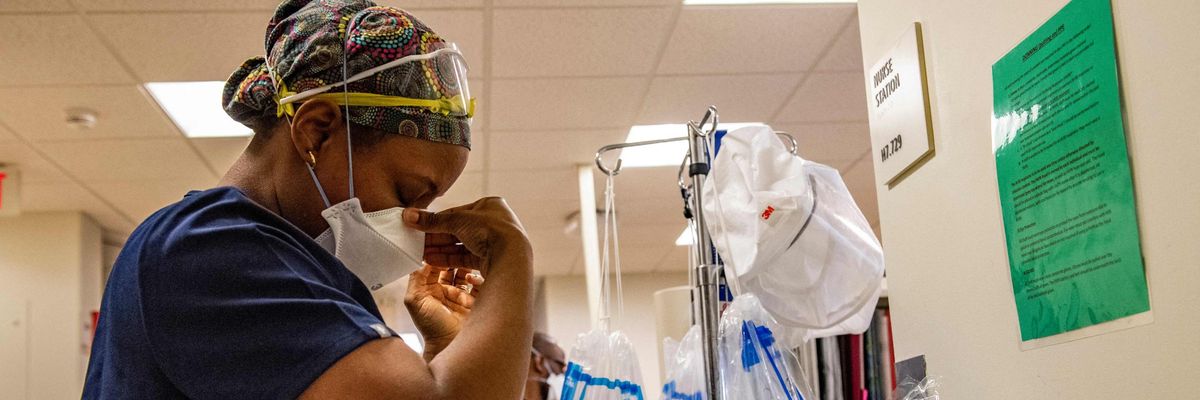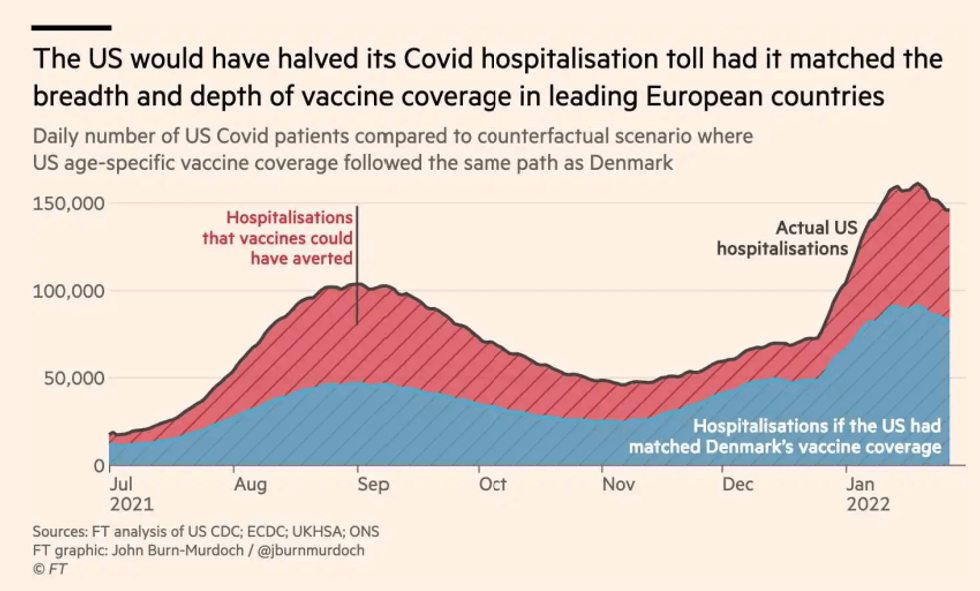The United States would have had nearly 50% fewer Covid-19 hospitalizations in recent months if its vaccination rates were the same as those of major European countries such as Denmark, where roughly 81% of the population has been fully inoculated.
That's a key finding of an analysis released Sunday by the Financial Times, which concluded that the comparatively low U.S. vaccination rate--64%--was responsible for roughly half of the country's hospitalizations this winter as the highly contagious Omicron tore through the population.
The figures compiled and visualized by FT show that "large pockets of unvaccinated or partially vaccinated people in the U.S. have placed more pressure on hospitals during the Omicron wave than in European nations with higher immunization rates," the newspaper reported.
"The analysis supports the findings of scientists and accounts of frontline medics who say lower vaccination levels are perpetuating the pandemic in the U.S.," FT added.
If the U.S. had the same vaccination levels across age groups as Denmark, the number of coronavirus patients in U.S. hospitals on January 19 would've peaked at 91,000, according to FT. If U.S. vaccination rates matched the U.K.'s or Portugal's, that figure would have been 100,000 and 109,000, respectively.
Instead, U.S. hospitalizations topped out at 161,000 on January 19, FT noted.
While hospitalizations have begun to level off in recent days after spiking due to Omicron, Covid-19 deaths in the U.S. remain sky-high. On Friday, the rolling seven-day average of daily U.S. coronavirus deaths hit 2,379, according to data from Johns Hopkins University.
At the start of 2021, the U.S. vaccine rollout ranked among the best in the world, quickly making shots available to the elderly, healthcare workers, and the immunocompromised while incrementally expanding eligibility to the rest of the adult population.
But by mid-year the pace of vaccinations had slowed rapidly, even as much of the eligible population had yet to receive one or both doses. Meanwhile, the U.S. denied much of the world its surplus doses and vaccine technology, hindering global inoculation efforts.
As FT put it Sunday, the U.S. "squandered its vaccination head start, falling far behind European peers in the race to vaccinate the most vulnerable."
The U.S. has since fallen well behind European countries in the administration of booster shots. Just 26% of the U.S. population has received a booster dose, compared to 61% in Denmark and 56% in the U.K.
Experts have attributed the lagging U.S. vaccination campaign to a number of factors, from rampant disinformation efforts by right-wing media outlets and politicians to structural impediments such as the lack of guaranteed paid leave.
"Wow, vaccine misinformation and anti-science have serious consequences," Madhu Pai, Canada research chair of epidemiology and global health at McGill University, tweeted in response to the FT findings.
In a blog post last month, researchers at The Commonwealth Fund argued that "efforts to improve access among populations with low vaccination rates and educate people about effectiveness and safety are necessary, but not sufficient, to increase vaccination rates in the U.S."
"Research suggests that some obstacles are especially prevalent in the U.S," they noted. "Despite the abundant supply, there are still 'vaccine deserts' where access is limited. Where vaccines are available, many people are unable to take time from off work."
The Biden administration's vaccination rule for large businesses would have required employers to provide workers with paid time off to get their shots, but the U.S. Supreme Court blocked the rule earlier this month.
"This is a rogue, anti-science Supreme Court," Rep. Mondaire Jones (D-N.Y.) tweeted at the time. "The far-right majority is risking the lives of millions of Americans to score cheap political points."


